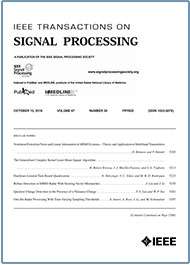Widely Linear Maximum Complex Correntropy Criterion Affine Projection Algorithm and Its Performance Analysis
Top Reasons to Join SPS Today!
1. IEEE Signal Processing Magazine
2. Signal Processing Digital Library*
3. Inside Signal Processing Newsletter
4. SPS Resource Center
5. Career advancement & recognition
6. Discounts on conferences and publications
7. Professional networking
8. Communities for students, young professionals, and women
9. Volunteer opportunities
10. Coming soon! PDH/CEU credits
Click here to learn more.
Widely Linear Maximum Complex Correntropy Criterion Affine Projection Algorithm and Its Performance Analysis
Recently, affine projection algorithm has been extensively studied in the Gaussian noise environment. However, the performance of affine projection algorithm will deteriorate rapidly in the presence of impulsive noise and other non-Gaussian noise. To address this issue, this paper proposes a novel affine projection algorithm based on the complex Gaussian kernel function, called widely linear maximum complex correntropy criterion affine projection algorithm (WL-MCCC-APA). With the maximum complex correntropy criterion (MCCC), the robustness of affine projection algorithm is improved significantly in the non-Gaussian noise environment, especially in the presence of impulsive noise. Meanwhile, a variable step size WL-MCCC-APA (VSS-WL-MCCC-APA) method based on fixed-point theory is proposed to further balance the convergence rate and steady-state misalignment of the algorithm. Finally, the step size boundary analysis and steady-state analysis are presented for theoretical analysis. Simulation results verify the correctness of obtained theoretical results and the superiority of the proposed WL-MCCC-APA and VSS-WL -MCCC-APA.
As an important part of modern signal processing systems, adaptive filtering [1]–[3] is widely used in channel equalization, system identification and echo cancellation in recent years. Among the adaptive filtering algorithms, the least mean-squares (LMS) [4]–[6] algorithm and the normalized least mean-squares (NLMS) [7]–[9] algorithm, due to their advantages of simple implementation and stable performance, have been widely studied and applied. LMS algorithm adopts the instantaneous square error as the error criterion, which has the characteristics of low complexity and easy implementation, but its convergence speed is slow. The NLMS algorithm is an improved form of LMS algorithm, which is essentially a variable step size LMS algorithm. However, the performance of LMS-type algorithms degrades appreciably when encountering colored inputs [10].
To address this problem, affine projection algorithm (APA) [11]–[13], as an extension of LMS-type algorithms, uses the input signals from the current and previous time instant to significantly reduce the influence of colored inputs. The APA is a trade-off between the classical LMS algorithm and recursive least squares (RLS) [14]–[16] algorithm, and can achieve a good balance between convergence speed and computational complexity.
SPS Social Media
- IEEE SPS Facebook Page https://www.facebook.com/ieeeSPS
- IEEE SPS X Page https://x.com/IEEEsps
- IEEE SPS Instagram Page https://www.instagram.com/ieeesps/?hl=en
- IEEE SPS LinkedIn Page https://www.linkedin.com/company/ieeesps/
- IEEE SPS YouTube Channel https://www.youtube.com/ieeeSPS












